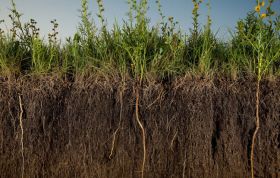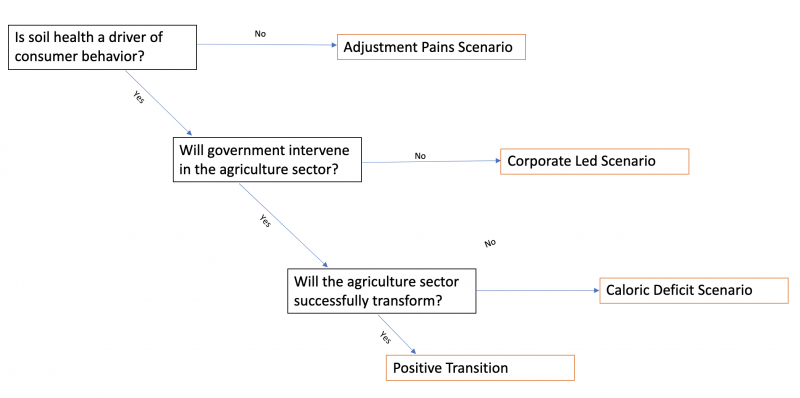Difference between revisions of "Regenerative Agriculture- Natural System Services"
| Line 49: | Line 49: | ||
==Fishbone Analysis== | ==Fishbone Analysis== | ||
[[Image:Fishbone.png]]<br> | [[Image:Fishbone.png|800px|]]<br> | ||
==Scenarios== | ==Scenarios== | ||
Revision as of 09:31, 13 December 2021
Team Members
Brendan Moroso
Neil Hazra
Safaa AlAdwan
Abhipreet Sinha
Anne-Floor Vet
Project Overview
Regenerative agriculture is a set of farming practices that employ nature-based solutions to achieve similar or superior results to those used in current industrial farming practices. By focusing on biological rather than chemical inputs, it takes advantage of services already being performed by plants and animals in a healthy ecosystem, leveraging biodiversity to boost yields. While there is no “official” definition of regenerative agriculture, it generally covers a number of practices including cover cropping, crop rotation and reduced tillage.
Studies from the Soil Health Institute show that regenerative agriculture on average costs slightly less per acre than industrial agriculture, and that two-thirds of farmers can experience improved yields. As it requires less petrochemical-based fertilizers, it also generally has a smaller carbon footprint, with some evidence showing it can even be carbon negative, drawing down carbon dioxide from the atmosphere and fixing it in the pedosphere (soil).
According to Project Drawdown 2018, roughly 20% of global croplands were farmed with one or more regenerative agriculture practices. By 2030, this percentage is projected to climb to roughly 55%. Its popularity is growing in-line with an improved understanding of soil and soil health, and the recognition that the extractive nature of industrial farming practices such as monocropping and synthetic fertilizer use can degrade croplands overtime, threatening returns. As a result, many companies have made substantial commitments towards incorporating regenerative agriculture in their supply chains.
The primary downside to regenerative agriculture is that it is more complex to manage, requiring more engagement and technical knowledge from growers.
This wiki examines several scenarios related to the roll out of regenerative agriculture in the decade from 2022 to 2032.
Sector Questions
Driving Forces
Fishbone Analysis
Scenarios
Scenario 1 - Adjustment Pains
Key Question: Is soil health a driver of consumer behavior?
Scenario Answer: No
Scenario Stats:
Surprising 6.5/10
Likely 5/10
Nobody would have thought that 2022 was the year that regenerative agriculture broke into the public consciousness. The fervor was intense, every grocery store suddenly had “Healthy Soils” labels on their products, and every fashion company had a clothing line featuring regenerative wool or cotton. But just as quickly as it arose, the fad disappeared. A few reports from NGOs highlighting farmers driven out of business by stringent monitoring requirements or big corporates exaggerating the impact of their practices was all it took to kill the hype. Suddenly consumers no longer cared, and so the “Save our Soils” labels quietly disappeared.
The agricultural industry, which had only begun adjusting to the regenerative movement, began to pivot back. Intercropping and crop rotation, where they had been adopted, were the first practices to be shed. The fact that multi-crop sales agreements and commodity listings never emerged, and that machinery companies were slow to develop farming equipment for blended fields almost guaranteed these practices would be the first to go.
Moreover, new developments in soil biology enabled similar results without needing to adopt complex practices. The industrial production of microbiological soil inputs empowered growers to inorganically boost the microbial health of their soils. Bayer and Syngenta acquired multiple biological farming input companies, eventually developing custom combinations of soil microbes designed to work in conjunction with their chemical inputs.
In the end, winter cover cropping was the only regenerative practice to hold on, and even then, it only persisted in Europe and a handful of other areas. In the US and elsewhere, ground water management legislation, aimed at refilling depleted aquafers, left farmers without enough water to spend on their primary crops, let alone a cover crop. Soil erosion increased, damaging watersheds and causing a year-on-year decrease in salmon redds in major rivers. However, in Europe, where changing Atlantic currents increased the intensity of storms, governments gave subsidies for seasonal cover cropping – viewing it as an affordable way to prevent erosion and flooding. Eventually these payments to landowners were automated through satellite-based crop monitoring, in a process considered by many to be highly biased and political.
The one part of the sector that stuck with regenerative agriculture was the high-end fabric industry. While technically accessible to all farmers, in-practice regenerative certification was only available to owner-operated growing operations, where multi-year commitments on soil growth were possible. While this pushed out food and animal feed, in fabrics the margins were higher and supplier relationships lasted longer. Patagonia in particular continued to be a leader in sourcing and marketing, with its regenerative organic winter clothing line selling out earlier and earlier every year.
By 2032 it was clear that the dream of regenerative agriculture, of growing crops AND growing the soil, would be as niche as organic agriculture. The oracles who had foretold of a future where regeneratively grown, nutrient-dense food would improve both human health AND planetary health were silenced.
However, in several areas, carbon farming as a specialty emerged. Here the stringent land ownership requirements and multi-year sequestration agreements worked in the grower’s favor. Acres of depleted farmland were planted by ever more farmers with specially bred grass blends, just to be knocked down and planted again, with every percentage growth of soil organic matter receiving its carbon credit payment.
Scenario 2 - Corporate Led
Key Question 1: Is soil health a driver of consumer behavior?
Scenario Answer: Yes
Key Question 2: Will government intervene in the agriculture sector?
Scenario Answer: No
Scenario Stats:
Surprising 6.5/10
Likely 5/10
Few people were surprised that 2022 saw the long-expected shift of consumer preference from conventional to green food production. It took almost a decade from the Paris Agreement to see actual changes in consumer behavior, but apparently the extra push from COP26 in Glasgow flipped the coin. Almost all consumer markets were screaming for brands producing their products in a regenerative way with a carbon-neutral footprint and fully transparent supply chains. In particular, the Asian market saw a quick adaptation towards a sustainable food production industry.
Multinationals, facing the brunt of pressure from activist groups like Green Peace, finally made big steps towards carbon-neutral supply chains. They fought to develop local food producers, to limit unnecessary transport distances. Customers, it seemed, would not accept empty shelves in the supermarket as a result of the environmental revolution. Innovative tech companies in the agri-business sector stepped into this gap and profited significantly from these desperate multinationals throwing money at technical solutions to keep their customers provisioned with their usual variety of food products. The introduction of vertical hydroponics inside climate regulated greenhouses made it possible to supply any food with a minimal carbon footprint and without contamination of the soil. Innovation prices had to be paid to adopt quick changes however.
Additionally, most brands and companies invested heavily in marketing campaigns to respond to the environmental desires of the customer. However, without government regulation or clear carbon accounting metrics to measure sustainability, it was difficult to distinguish greenwashing from actual contribution. The battle between the brands became detached from reality, subjective and marketing driven.
2025 was the high-water mark for consumer perceptions of environmental responsibility. According to market research published at the time by the HBR, a majority of the global population was willing to spend significantly more for sustainable and soil protective products. The main winners of consumers' willingness to compromise on price for food produced in a regenerative way were local organic brands and multinationals. Medium-sized food companies, who lacked the capital to change their entire supply chain to meet customer expectations, continued to rely on conventional agriculture and suffered as a result. The lack of governmental subsidies prevented investments towards regenerative agriculture for the companies not supporting the shift themselves. The only option for these companies to compete with was to lower their prices.
By 2027 this consumer-driven revolution led to notable carbon reduction for the agricultural sector. However, that same year also saw the highest global price inflation in the food sector since the 1950s. The divide between price fighters using conventional agriculture and the fancy feel-good brands led to economic inequalities between the population profiting from the environmental revolution and those not able to adapt. By present day this gap metastasized into a problem for our health systems - price fighters were improving their yields through increased use of chemicals and antibiotics, with predictable results. The question then arose, who is finally going to pay for the difference in the future?
Scenario 3 - Caloric Deficit
Key Question 1: Is soil health a driver of consumer behavior?
Scenario Answer: Yes
Key Question 2: Will government intervene in the agriculture sector?
Scenario Answer: Yes
Key Question 2: Will the agriculture sector successfully transform?
Scenario Answer: No
Scenario Stats:
Surprising 6.5/10
Likely 6/10
Scenario 4 - Positive Transition
Key Question 1: Is soil health a driver of consumer behavior?
Scenario Answer: Yes
Key Question 2: Will government intervene in the agriculture sector?
Scenario Answer: Yes
Key Question 2: Will the agriculture sector successfully transform?
Scenario Answer: Yes
Scenario Stats:
Surprising 3/10
Likely 5/10

